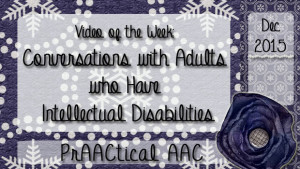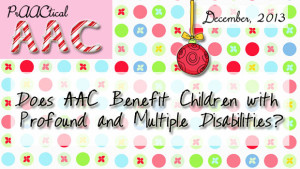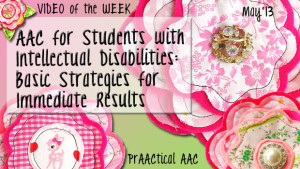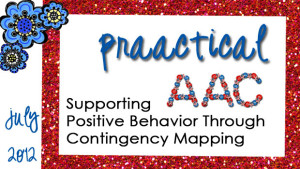December 23, 2015
by Carole Zangari -

There is much to love about these video segments showing adults with intellectual disabilities interacting with their peers and caregivers in a supported community living environment. For starters, we love seeing successful interactions that focus on social connectedness, sharing information and true participation, as opposed to requesting and behavior regulation. Notice the tone of these conversations and the supportive strategies that the caregivers use. The residents are respected, empowered, and successful. And, of course, we love seeing the use of multiple modes of communication! Many thanks to the staff and residents of Inner South Communication Service of Victoria, Australia for making these videos available.
Filed under: Video of the Week
Tagged With: adults, Conversation, intellectual disability
December 10, 2013
by Carole Zangari -

For most SLPs, it is easy to see how AAC can be beneficial to someone with motor difficulties, like cerebral palsy or ALS. To say that AAC strategies and technologies can be life-changing for these individuals is not an understatement. Similarly, the fields of SLP and special education now recognize that visual supports and AAC options are a standard of care for people affected by autism who have little or no functional speech. Not only does AAC provide a means for functional communication, but it also plays facilitative important role in speech and language development. To be sure, there are significant challenges in the implementation of AAC supports and services with these populations, but the practices themselves are now widely recognized for their positive impact on communication, literacy skills, independence, and behavior. But what about individuals with the most significant learning challenges? In this post, we share an article looking... [Read More...]
Filed under: PrAACtical Thinking
Tagged With: beginning communicator, intellectual disability, PMLD, prelinguistic communication, research support
May 12, 2013
by Carole Zangari -

A good number of SLPs in school settings serve students with intellectual disabilities, some of whom who use or need AAC. In this video by ASHA, Dr. Krista Wilkinson and Ellen Kravitz of Easter Seals in Massachusetts, discusses many prAACtical issues that arise in doing this work. A number of years ago when I was the Coordinator for the ASHA Special Interest Division on AAC, I had the opportunity to work with a team of SLPs who were fully committed to educating SLPs about AAC. Ellen spearheaded the effort to create this webinar, along with the support of Diane Paul, Karen Niles, and many other wonderful people at the ASHA National Office. We were delighted to host ASHA’s media team at our university SLP clinic to do some of the taping for this program. Thanks to the generosity of ASHA and ASHF, this presentation is offered both in the free version and... [Read More...]
Filed under: Video of the Week
Tagged With: ASHA, cognitive impairment, Ellen Kravitz, intellectual disability, Krista Wilkinson, strategies
July 21, 2012
by Carole Zangari -

This month we’re focusing on visual supports and strategies to support positive behavior. We’ve talked about transition supports and environmental arrangements. Another way to help therapy sessions run smoothly and keep the focus on learning (rather than managing behavior) is to take proactive steps to make the expectations clear. For most people who are learning AAC, that means making sure there is a visual representation that accompanies the verbal explanation. – Many SLPs create a list of rules for expected behavior. In this post, we’ll talk about the research-supported strategy of using contingency maps. Contingency maps are a visual depiction that shows the desired behavior and the outcomes of two divergent paths: one where the learners engage in the desired behavior and the other that shows what happens if they don’t engage in the desired behavior. If you’re familiar with behavioral approaches, this strategy is right up your alley. The... [Read More...]
Filed under: Strategy of the Month
Tagged With: ASD, behavior, contingency map, developmental disability, intellectual disability, positive behavior support, visual supports



